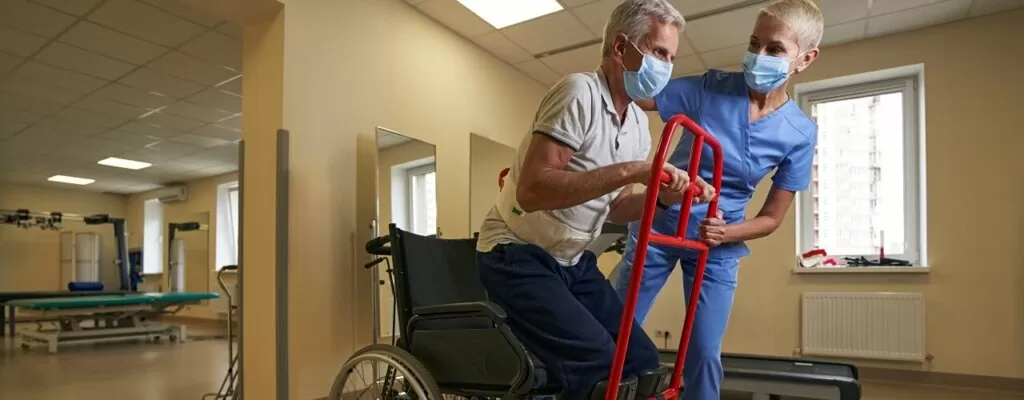Our in-home physical therapists will help you avoid post-stroke injury and complications with stroke rehabilitation.
Have you or a loved one recently suffered a stroke? Recovery from this medical emergency can take months or even years, and the effects on your life can be profound, including severely limiting your mobility. At First State Rehab at Home, we offer in-home stroke rehabilitation to help prevent one of the most significant risks after a stroke: falling.
A stroke occurs when blood flow to the brain is blocked, either because of a blood clot or because of a burst blood vessel in your brain. If your brain isn’t getting blood, it isn’t getting oxygen, and your brain cells will die within minutes of the stroke.
While modern medicine has made surviving a stroke more likely, rehabilitation afterward can be a long, difficult process. Among the many varied aftereffects of stroke is an increased risk of falling, which can lead to serious injury. Fortunately, a dedicated stroke rehabilitation program can help reduce your fall risk.
But for many people, recovery from a stroke severely impacts their mobility. If it’s difficult for you to leave your house, you may wonder how you could even get to a physical therapy clinic in the first place! That’s why First State Rehab at Home offers in-home physical therapy . We’ll bring our fall prevention treatments right to your front door!
To learn more about our in-home stroke rehabilitation services, request an appointment today.
The Relationship Between Stroke Recovery and Falling
Strokes affect the brain–you might think of them as a “brain attack” (as opposed to a heart attack). And because our brain controls our movements, memories, emotions, language, and more, the aftereffects of a stroke can vary wildly.
Out of all the aftereffects of a stroke, however, falling is one of the most common, with one study reporting that 37% of stroke survivors fell at least once in six months. Another study found that stroke survivors were more likely to experience recurrent falls than older participants who had not experienced a stroke. They were also more likely to fear falling.
Falling can lead to injury, including bone fractures, making day-to-day living even more challenging. A severe fall can seriously interfere with stroke rehabilitation, as can the fear of falling. If you’re worried about a fall, completing necessary recovery activities becomes more challenging.
But what’s the reason for this increased fall risk among stroke survivors? It goes back to a stroke’s effect on our brain. Many people will experience weakness or paralysis on one side of their body after a stroke, dramatically affecting their balance and walking ability. Cognitive impairment can also play a role in this reduced risk, as can the side effects of your medications.
Finally, it’s important to remember that the risk of falling increases with age–the same as the risk of stroke. Essentially, the aftereffects of a stroke compound the age-related risk factors of falling.
How First State Rehab at Home In-Home Stroke Rehabilitation Can Help Prevent Falls
Your stroke rehabilitation program will consist of strength, gait, and balance training exercises, all customized to suit your needs. We’ll also provide any of the necessary equipment, show you how to perform all exercises correctly, and provide a gradual escalation of intensity to ensure you don’t injure yourself.
Strength Training:
We’ll focus on rebuilding any weakened muscles, with a special emphasis on your core muscles, as your core plays a significant role in balance and stability. Our therapists will match the exercises to your ability level, providing modifications as needed. For example, several exercises performed while sitting, such as seated knee lifts or trunk twists, can have a big impact.
Balance Exercises:
As you recover from your stroke, it’s important to complete dedicated exercises designed to improve your stability. These exercises might sound basic, but they help rebuild the connection between your mind and body, restoring your balance.
When you first start, you’ll complete your balance exercises while holding onto a counter. As you see improvements in your balance, you can move on to performing the same movements without holding on to anything.
What movements will you be completing? It varies, but simple calf raises or side steps are great beginner exercises.
Gait Training: A stroke can dramatically alter your gait, making walking harder and leading to falls. Our therapists will start by assessing your current walking pattern before developing a personalized approach to correct the impairments that may be causing you trouble.
In addition to walking with you and providing hands-on corrections, our therapists can train you to use assistive devices, such as a cane or walker. We can also help you modify your home so you can more easily navigate your space without assistance.
Start Your In-Home Stroke Rehabilitation Program Today!
At First State Rehab at Home, we understand that the fear of falling after a stroke can prevent you from staying active and working on your recovery. With simple, customized exercises, we’ll help you recover strength and balance so you can decrease your risk of falling and focus on worry-free healing–without ever leaving your house!
To schedule a consultation and learn more about in-home physical therapy services, call to request an initial consultation.
Sources:
- https://www.ncbi.nlm.nih.gov/pmc/articles/PMC6371176/#B1-geriatrics-01-00031
- https://www.cochranelibrary.com/cdsr/doi/10.1002/14651858.CD008728.pub3/full
- https://www.physio-pedia.com/Gait_Training_in_Stroke
Tags: stroke rehab, Physical Therapy, Physical therapist, Natural Treatment, Natural Pain Relief, Pain Relief



